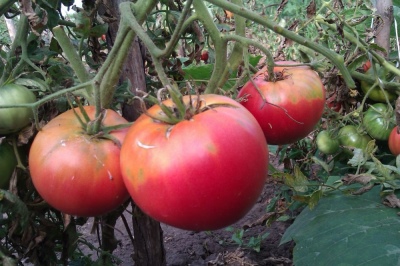
- Category: grade
- Growth type: indeterminate
- Appointment: fresh consumption, for pickling and preserving, for juice, for ketchup and tomato paste
- Ripening period: mid-season
- Ripening time, days: 110
- Growing conditions: for open ground, for greenhouses
- Bush size: tall
- Bush height, cm: 100-180
- Bush characteristic: powerful
- Leaves: large
Each coming spring is a pleasant occasion to plan and select varieties. The problem is simplified by knowing exactly the expected result. Fans of large-fruited salad varieties need to pay attention to the indeterminate variety Giant raspberry. The tomato berry is great in all respects - beautiful, tasty, used in slicing, in salads, in cooking, as well as for cooking sauces and juices. The variety is intended for outdoor cultivation in all types of greenhouses. It is difficult to call it unpretentious, but with due diligence, even a novice gardener can cope with it.
Breeding history
The tomato is not included in the State Register of Breeding Achievements of the Russian Federation, contrary to the claims of some seed distributors. Only the Giant variety is listed in the registry catalog, therefore the Giant raspberry can be considered its variety.
Description of the variety
Tall (100-180 cm) powerful, well-leafy bushes are covered with large, dark green leaves with light pubescence. The yellow flowers are collected in simple inflorescences, forming clusters with 2-3 berries firmly attached to the articulated peduncle.
The main features of the Raspberry Giant:
large-fruited and good productivity;
amicable ripening on the brush, long-term fruiting;
high marketability and taste, attractive appearance;
strong immunity, versatility, transportability, resistance to cracking, good keeping quality.
If we talk about the shortcomings, then these are more likely increased requirements - the need for formation, tying, pinching, mandatory compliance with agrotechnical requirements, since their violation negatively affects the development of the plant.
The main qualities of the fruit
Large (from 300-500 g and more) ripe fruits have an excellent color of saturated dark pink, almost raspberry color. The shape of the berry is flat-round, with slight ribbing in the region of the stalk.
Taste characteristics
The sweet and juicy dense pulp has a pleasant dessert taste, piquant sourness, and sugary at the break. Thin, but dense skin is almost not felt during eating, reliably protects the fruit from cracking. The amount of dry matter is about 5%, sugars 2.4%, 5-6 seed chambers contain a small amount of seeds with good germination rates.
Ripening and fruiting
The tomato belongs to the mid-ripening category - the period of amicable, but long-term ripening is from 110 days. The harvest begins in July and continues until September.
Yield
The high-yielding Raspberry Giant allows you to collect up to 10 kg of fruits from the bush, but only if agrotechnical requirements are met.
The timing of planting seedlings and planting in the ground
Sowing for seedlings falls on January - early March, while it should be borne in mind that seedlings are transferred to the ground after 2.5-3 months. The timing can be adjusted based on the climatic features of the area.

Growing tomato seedlings is an extremely important process, because it largely depends on whether the gardener will be able to harvest at all. All aspects must be taken into account, from seedbed preparation to planting in the ground.
Landing scheme
The optimum density of vigorous plants is 2 to 3 roots per sq. meter or 50x50 cm.

Growing and care
A powerful large-fruited, spreading plant grown in the traditional seedling method. Before planting, the soil for tomatoes is enriched with organic matter (humus, compost, bird droppings), mineral fertilizers, and wood ash. The soil must be not only nutritious, but also breathable so that the root system is saturated with oxygen.
During the preparation of the ridges, it is necessary to install a support in advance or organize a strong trellis. Bushes need mandatory shaping (1-2 stems), pinching and tying. Young, freshly planted seedlings need initial shading from the scorching sun, even in a greenhouse that creates a greenhouse effect.
Further care consists in regular and timely watering, weeding, fertilization, hilling or mulching. It must be remembered that waterlogging leads to the appearance of late blight. Greenhouses need to be ventilated, excess foliage is removed from the bushes, and after the mass ripening of the berries begins, the leaf is removed almost completely.




A plant needs different micronutrients at each stage of growth. All fertilizers can be divided into two groups: mineral and organic. Folk remedies are often used: iodine, yeast, bird droppings, eggshells.
It is important to observe the rate and period of feeding. This also applies to folk remedies and organic fertilizers.
Disease and pest resistance
The crimson giant is well resistant to many viral, bacterial, fungal diseases characteristic of the nightshade family. Top rot and brown spotting are the most likely troubles, as are pest attacks, therefore, preventive treatments with insecticides and fungicides are mandatory.


Resistant to adverse weather conditions
Despite its good immunity, the variety does not tolerate prolonged cold snaps and prolonged rainy weather very well.
Growing regions
The tomato is adapted to a mild and warm climate, therefore it is most successful in regions with a large number of SAT - Astrakhan, Belgorod, Voronezh, Saratov regions, as well as Krasnodar Territory, Crimea, Caucasus.

























































































